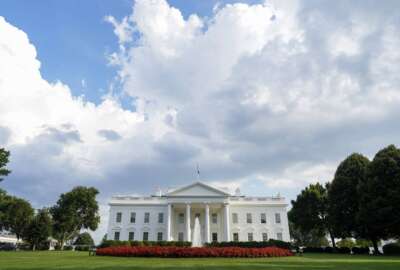Hubbard Radio Washington DC, LLC. All rights reserved. This website is not intended for users located within the European Economic Area.
Lawmakers debate future of DHS headquarters project
House Homeland Security Committee lawmakers and GAO highlighted funding shortfalls and a need to update plans. Meanwhile, Senate Homeland Security and Governmen...
House and Senate lawmakers issued dueling opinions over the future of the Homeland Security Department’s headquarters consolidation project at the St. Elizabeths campus in Washington.
At a hearing Friday, members of the House Homeland Security subcommittee on management and oversight encouraged DHS and the General Services Administration to go in a different direction. Rep. Jeff Duncan (R-S.C.), chairman of the subcommittee, called the project a monument to mismanagement and added that there are more important funding priorities right now.
Rep. Ron Barber (D-Ariz.), subcommittee ranking member, said the problems with St. Es is a combination of funding shortfalls due to congressional shortcomings and DHS and GSA banking on outdated plans.
This isn’t the first time the committee has expressed concerns over DHS’ plans and actions. In January, Duncan released a report calling into question the planning process that went into choosing St. Elizabeths, and whether economic conditions have changed so much since the project began that St. Elizabeths is no longer the best option for DHS.
This hearing reinforced those same issues outlined in that report nine months ago.
The Government Accountability Office also criticized DHS’ and GSA’s plans, saying in a report released Friday that the two agencies didn’t conduct an assessment of current needs and capability gaps, nor have they looked at alternate designs to help deal with the increased costs.
Two reasons to fund St. Es
On the other side of Capitol Hill, the Senate Homeland Security and Governmental Affairs majority staff countered with its own report detailing all the reasons why Congress should make St. Es a priority over the next decade.
The committee said the report reaches two conclusions:
- Consolidating the department at St. Elizabeths will improve DHS’ ability to carry out its mission. The committee interviewed all four former DHS secretaries, three former deputy secretaries and two former undersecretaries for management. They all agreed that consolidation will improve crisis management, focus agencywide efforts, improve morale of employees and reduce management inefficiencies and travel expenses.
- Finishing the consolidated DHS headquarters makes good fiscal sense, saving as much as $1 billion over the next 30 years. As has been the call by DHS leaders and many members of Congress over the last decade, DHS spends hundreds of millions a year leasing space at more than 50 facilities across the Washington, D.C., region. The committee estimated that the government could save about $700 million over 30 years in lease costs alone through the consolidation.
“In an era of shrinking budgets and economic uncertainty, figuring out which priorities to fund can be difficult,” said Sen. Tom Carper (D-Del.), chairman of the committee, in a statement. “It may be easier to cut long-term investments that have yet to bear fruit than to make tough decisions about other pressing priorities. However, as this report concludes, completing a consolidated headquarters for the department will not only save nearly a billion taxpayer dollars, it will help our nation better prevent and respond to terrorist attacks and other disasters. Given its importance, the St. Elizabeths DHS consolidation project should remain a funding priority, and Congress and the administration should come together on a plan to move forward with the project.”
No matter which side of Capitol Hill is more accurate or has a stronger case, the facts are real: DHS already is 11 years off schedule and would spend $1 billion more if St. Elizabeths is completed on its current schedule of 2026 at a cost of $4.5 billion.
What’s clear from both of these dueling reports is fault can be laid on both ends of Pennsylvania Avenue. Congress hasn’t made a consolidated DHS headquarters a priority over the last five years, and the Obama administration decided to focus funding priorities on other areas. These are among the root causes for the delays and rising costs.
Funding was $1.6 billion short of request
Over the last eight years, Congress met the White House’s budget requests only once when former President George W. Bush requested $38 million in 2006 for phase one construction of the Coast Guard’s headquarters and St. E’s west campus infrastructure.
The following year, Bush requested $360 million and Congress appropriated $6 million.
GAO found the funding gap between what was requested and what was received from 2009 through 2014 was more than $1.6 billion.
At same time, former DHS Secretary Janet Napolitano decided in 2012 to put a majority of the program on hold until the budget situation improved, causing further delays in the project. Besides the one-time boost in funding under the Recovery Act, the White House hasn’t put a lot of emphasis on St. Es.
Chris Cummiskey, the acting undersecretary for management and chief acquisition officer at DHS, pushed back against Duncan’s comments that the program is a monument to failure.
He said there is no finer project management team at DHS and GSA than the one working on St. Es.
“These are individuals that know how to deliver projects. They’ve done it with phase one for the Coast Guard and will continue to do with support from the Congress,” Cummiskey said. “We have programs across the DHS portfolio that are troubled, but I do not view this as one of them.”
DHS and GSA say they delivered phase one of the project on time and on budget in August 2013 when the Coast Guard’s new headquarters opened.
New project plan in the works
Cummiskey said DHS agreed with GAO’s findings, and he issued an acquisition memo requiring the parts of the St. Es project in 2014 and 2015 that are under their control — about $92 million in real and requested funding — are now subject to the department’s acquisition review board process.
Norman Dong, the commissioner of the Public Building Service at GSA, said the project continues to move forward. GSA will award a contract in the next few weeks for design and build services to make the historic Center Building available for the government to use. Congress allocated the project $155 million in 2014, and GSA requested another $250 million in 2015 to improve the infrastructure and finish the renovations of the Center Building.
“Looking beyond our budget request, GSA is identifying other potential sources of funding to support this project. For example, with our Federal Triangle South project, we are looking to exchange our regional office building as well as the vacant Cotton Annex for additional construction services at St. Es,” Dong said. “We are working with DHS to enhance the master plan for St. Es, which will further improve space utilization and create even greater savings.”
Cummiskey said when DHS submits its 2016 budget request to Congress, it will include an updated project plan that takes into account GAO’s recommendations, including those from the administration’s Freeze the Footprint initiative and other changes in the federal real property environment.
RELATED STORIES:
DHS St. E’s to be victim of budget axe
Duncan calls for reality check on DHS headquarters project
Ribbon cut at new Coast Guard HQ in Southeast
Copyright © 2024 Federal News Network. All rights reserved. This website is not intended for users located within the European Economic Area.
Jason Miller
Jason Miller is executive editor of Federal News Network and directs news coverage on the people, policy and programs of the federal government.
Follow @jmillerWFED





